 |
| back || next |
| The main building was a two-story brick structure measuring 42 feet by 74
feet. It housed administrative offices, classrooms and a library. Mrs. Jewel Link Luckett,
wife of President Samuel Luckett, offered $2000 toward adding a wing to the original
structure, provided the trustees pledged to finish it. In June 1891, the board of trustees
appropriated $4000 for the purpose of completing a two-story wing on the west side. In
1894, F. M. Files donated a cotton compress to the school. It was sold and the proceeds
used for the erection of an east wing. Trustee and east Texas lumber baron, J. M.
Thompson, donated $500 worth of lumber to be used in the building. |
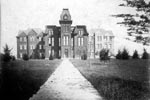
Main Building 1895
[
large image ] |
|
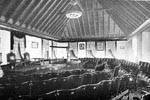
Files Hall
[
large image ] |
The upper stories of these wings were furnished as meeting halls for the
literary societies. Cadets petitioned tirelessly for a gymnasium. In fact, Old Main,
eventually did house a fine gymnasium, but not until several years later. |
|
| Membership in one of the literary societies was mandatory. Cadets were
not only required to join, they were required to attend the meetings. The purpose of the
societies was to promote education in rhetoric. Those who could not bring themselves to
associate with either the Athenaeum or Philennoian Society were forced to attend a class
in rhetoric in addition to their regular studies. |
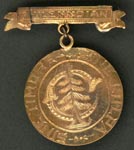
Winners of declamatory and
oratorical contests were awarded gold medals by the literary societies.
[
large image ] |
|
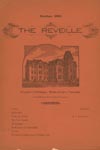
Reveille issue
[
large image ] |
The Reveille was the organ of the literary
societies on campus. It began and flourished during the military era, but continued
publication through 1907. It was a a monthly literary magazine which contained editorials,
articles on literary, historical, and political subjects, "exchange" notes or
excerpts from other institutions’ publications, campus news, and anecdotes. Very
little concerning college life escaped mention, making The Reveille
the most complete existing record of the military years at Austin College. The first issue
appeared in March, 1891. The Reveille ceased to exist after
1907, supplanted by the annual Chromascope, but no student publication since has
adequately taken its place. |
|
| Cadets followed a classical liberal arts curriculum. The college catalog
stressed that great care had been given to the arrangement of the required course of study
"to select such subjects as are best suited to give the mind thorough and varied
training, and, at the same time, to fill it with the largest store of valuable, practical
truths." During the military decade, curriculum was revised to reflect a new modern
era. In 1890-91, Bible Studies were added to every term of every year. Students could
pursue one of two courses of study: classical or scientific. During the 1890s, a course in
Old English was added and two years of modern languages (Spanish, French, German) could be
substituted for part of the Greek and Latin requirement. |

Course of study 1890
[
large image ] |
|
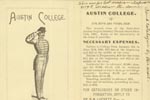
Expenses
[
large image ] |
Approximate cost for one year for a cadet who paid room and board was
$240.50. This included two uniforms and laundry service. Students could rent a dormitory
room for $1.00 per month, and purchase meals for $8.00 to $12.50 per month depending on
whether they ate at a boarding house or the Student Mess Club. Dormitory students were
expected to provide their own furnishings. |
|
On January 5, 1891, the following Library rules were adopted:
- The Library will be open for an hour after drill on Wednesday; from 9 to 11 a.m. on
Saturday.
- Papers must not be removed from the room.
- Any student wishing to take a book from the room must first give his name and the name
of the book to the Librarian to be placed on the register.
- No student shall be permitted to take more than two books from the Library at a time,
and these must not be kept out more than two weeks.
- Persons keeping books out over two weeks will be charged five cents per day for each day
over time, to be paid to the Librarian, and any student refusing to pay shall be
prohibited from using the Library.
- Any student damaging or losing books must refund the amount of damage or loss.
- No disorderly conduct in the room or disarranging of books will be allowed.
Library hours were soon expanded to one hour each Tuesday and Thursday afternoon as
well as Saturday mornings. The Library fee was fifty-cents per semester. |
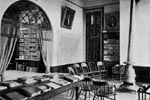
Library Reading Room
[
large image ] |
|

[
large image ]
Studying in his room. Some
students "from a distance" boarded in homes near the campus like that of W. H.
Venable, Sr., located across the road from the College. |
Study hall was mandatory, although requirements for it changed from time
to time. Prior to the opening of the fall term in 1891, the faculty decreed that those
whose monthly grades fell below 80 be required to attend. At other times all students were
required to attend, at still others, seniors were excused. In 1890-91, Study Hall
commenced at 7:15 p.m. and ended with tattoo at 10:00 p.m. This scheduling served the dual
purpose of encouraging study and keeping cadets "on the hill" at night. |
|
|
|
back || next |

